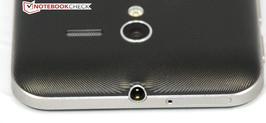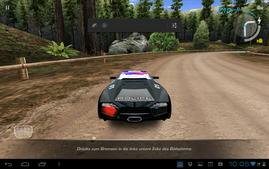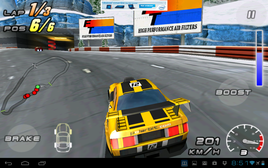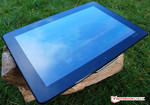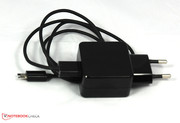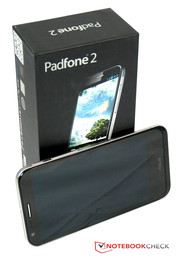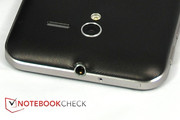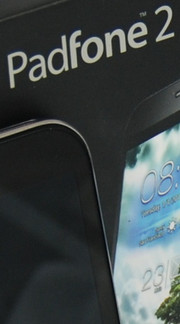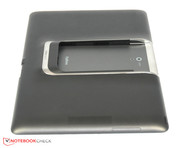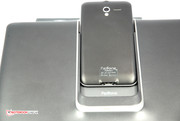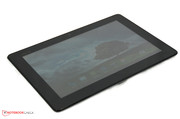Review Asus PadFone 2 Smartphone

For the original German review, see here.
No, we have no ethical concern about how low-necked the Asus PadFone 2 is. The station of the PadFone 2 looks impressive nonetheless - a sleek, premium looking 137.9 x 68.9 x 9 mm smartphone, which docks at the back of the 263 x 180.8 x 10.4 mm large station without a cover. Our review will reveal whether this new freedom is as practical as it is chic. The Asus PadFone 2 has changed not only on the outside, but also on the inside. The powerful Quad Core 1.5 GHz Qualcomm Snapdragon S4 Pro processor ensures that the PadFone 2 has not only the looks, but also the brains. While the predecessor had only 1 GB of RAM, the new model goes further with a total of 2 GB RAM. As for the display, the first generation had a 4.3-inch Super AMOLED display with crisp colors and good contrast. The PadFone 2 relies on a 4.7-inch Super IPS panel with a resolution of 1280 x 720 pixels. The IPS panel of the tablet has the handy size of 10.1 inches and a resolution of 1280 x 800 pixels. In the following review we will look into how the display and overall concept of the PadFone 2 fares against the original PadFone.
Case
Sleek, chic, light. This is the first impression that the PadFone 2 leaves us with. Taking the smartphone in hand we notice the low weight of 135 grams, the sleek design, and the appealing material of the back. Just like the predecessor, it is made of plastic, with fine grooves forming concentric circles. But it is no longer in the grey-brown tone, instead comeing in classy, matte black. The rough surface offers good grip and is safe from unattractive fingerprints. Visually appealing is also the surrounding frame made of matte brushed aluminum. The embedded volume rocker and power button are also made of the same metal material and add to the impression of superior quality. The edges are pleasantly rounded, burr-free, and do not scratch the ear while talking on the phone. Everything is good, both in terms looks and feel. Asus has opted for a 4.7-inch (previously 4.3) display. The phone is a svelte 9 mm, which makes it extremely friendly to most pockets.
Black makes you look slim. In the case of the PadFone 2 station, this is less due to the color choice – the tablet has been slimmed considerably, measuring 263 x 180.8 x 10.4 mm, it is a good 3 mm thinner than the 13.55 mm "thick" predecessor. This is mainly due to the absence of a user replaceable battery. A cover has been completely omitted. Another difference is that the smartphone is no longer inserted sideways, but vertically into the bay at the back of the station. The new docking method cannot change the fact that the use of the tablet on a desk is a wobbly experience. The back of the PadFone 2 station is just as uneven as that of its predecessor.
The station has also undergone a facelift in terms of the material of construction and color used. The plastic back of the station is black as well, but unlike the smartphone, it does not have the fine grooves, being lightly rubberized instead. This ensures secure handling and good grip. The matte black back still attracts fingerprints. Overall, the case leaves an impression of high quality, is stiff, and can barely be twisted.
Connectivity
Since the tablet itself is nothing more than a touch screen with a battery, we take a closer look at the features of the clever partner device.
The PadFone 2 boasts the brand new 1.5 GHz Qualcomm Snapdragon S4 Pro APQ8064A Quad Core processor and 2 GB RAM, which is pretty powerful equipment, ensuring good performance in the tablet mode as well. The Adreno 320 graphics chip provides high quality imagery and according to the manufacturer, it can unleash its full potential with the installed Super IPS panel.
The interfaces can be listed quickly: a microSIM card slot and a 13-pin dock connector (it supports micro USB 2.0 and Mobile High Definition Link for HDMI). The Padfone 2's charging port is at the bottom. The predecessor had this port on the side of the unit, which made talking while charging the phone somewhat awkward. The audio jack is located in the middle of the upper edge. Asus has omitted expandable memory this time with the PadFone 2 being available in the 32 GB and 64 GB iterations.
The station itself has, in addition to the essential smartphone connector, a 13-pin port (Micro USB 2.0 Host) for charging.
Software
The PadFone uses Android 4 Ice Cream Sandwich. An upgrade to Android 4.1 has been promised by the manufacturer. Noteworthy feature of the PadFone 2 is the "intuitive" handlingof the dock. When changing from the smartphone to the tablet, the displayed content will be automatically transferred to the tablet's screen and adapted to the new format. Active applications recognize the moment of change and continue seamlessly.
The predecessor sometimes needed a reconnection to the station in order to resume the running applications. We'll see later on if this problem is present in the PadFone 2. Another innovation is that the PadFone 2 offers a new version of the app, SuperNote, which transforms handwriting into typed text. In addition to this, the Instant Translation application translates texts in e-mails and websites, thus making third-party translation tools obsolete, at least according to the manufacturer.
CommuniCation & GPS
Bluetooth 4.0 allows wireless data transmission to other Bluetooth-enabled devices – only over short distances of course. On the road, the PadFone 2 can connect to the Internet via the high speed HSPA+ or LTE standards, the next stage of UMTS. The supported frequency bands are: 900 and 2100 MHz for 3G and 800, 1800 and 2600 MHz in 4G networks. The initial satellite lock with the integrated GPS module takes a couple of minutes. Reception remains stable only near the window of a room.
Cameras & Multimedia
At the back of the PadFone, we find a 13-megapixel camera. Therefore, at least on paper, the PadFone 2 is superior to most cell phone cameras. But this high theoretical quality is brought "down to earth" by a somewhat small sensor. Asus has made a good choice with the aperture of f2.4. The manufacturer has upgraded the new model heavily in comparison to the PadFone 1, which only had an 8-megapixel camera. New is the Burst Mode, which can take up to 100 photos at six shots per second.
The camera is really good for a cell phone, the colors are great and we cannot fault the sharpness either. With 13 megapixels, the PadFone 2 is definitely among the better equipped smartphones.
Both the phone and the station feature a front-facing camera, which is located above the display and has a resolution of 1.2 megapixels in the smartphone and one megapixel in the tablet. As it is expected, the quality is not amazing, but suffices for video chats, say over Skype.
Accessories
In addition to the AC adapter, in the box we find a charging cable for the Padfone 2 and the docking station. This is a positive upgrade as the previous model had two different charging cables, but only one AC adapter. The annoying unplugging is over since the 13-pin connector fits on both devices. In the package, there are also instructions and warranty information, as well as in-ear headphones, including earbud replacements.
Asus has omitted the PadFone Stylus which was supplied with the first generation and served as an input device and headset in one. The Station Dock, the optional keyboard for the first PadFone, will not be available for the current model. Instead, Asus offers the user a 50 GB online storage, free for a period of two years.
Warranty
Asus delivers the PadFone 2 and the station with a two-year warranty, including a Pick-Up & Return Service. The warranty applies to Germany and Austria.
Games
Modern games like Need for Speed: Hot Pursuit and Raging Thunder 2 run smoothly with the integrated Adreno 320 graphics chip. There are small stutters here and there, but they are almost not worth mentioning. The responsive gyroscope does the rest. Nothing stands in the way of enjoying the occasional game.
Input Devices & Controls
Prompt and reliable – this is how the capacitive touch screen of the Android 4.0 Ice Cream Sandwich based PadFone 2 reacts. While the first generation's display did not always "react" instantly, the one on the Padfone 2 scores points with its responsiveness and precision. The 10.1-inch tablet display does not – at least subjectively – fall behind the smaller device. Both the station and smartphone fared equally well in rotating display content 180 degrees.
Overall the mobile duet makes a good impression in terms of handling and control. The first PadFone model wobbled a bit when inserted in the station. A reliable and instantaneous transfer of the image to the tablet was not always the case and the user was greeted with a black screen now and then. The PadFone 2 manages the connection and the screen content adjustment significantly better.
On the other, the implementation of the 13-pin connector is not so successful. It is really small and very fragile, making it somewhat clumsy to use. The 5 mm connector can be easily damaged by plugging it in at the wrong angle or even upside down. Cautious use is advised. The same is true for the station connector. Because there is no cover any more, the smartphone docking connector is out in the open and is not protected from dirt or physical damage. Therefore, the tablet should be protected accordingly, especially when travelling.
Display
Just like the first generation, the tablet has a 10.1-inch IPS panel covered with scratch resistant Corning Glass and a resolution of 1280 x 800 pixels. Let's take a look at the illumination. The maximum brightness at the nine measurement points is between 267 and 316 cd/m2 and is thus slightly higher than the predecessor. As before, it lacks a bit of luminance for enjoyable outdoor use. Although the values have been improved, subjectively not much has changed. The brightness remains less than ideal and the reflective surface doesn’t help either.
However, Asus has changed a lot on the smartphone's display. First of all, it is now 4.7 inches, larger than the 4.3-inch predecessor. The manufacturer has also changed the Super AMOLED panel for an IPS one. The IPS panel has a resolution of 1280 x 720 pixels and is significantly better than the display of the predecessor. Crystal clear images and a very good black level follow as a result. The maximum brightness at the nine measurement points was between 495 and 558 cd/m2 .
| |||||||||||||||||||||||||
Brightness Distribution: 89 %
Center on Battery: 542 cd/m²
Contrast: 2168:1 (Black: 0.25 cd/m²)
In terms of measured values, the smartphone is significantly ahead and leaves the tablet display out in the cold. The PadFone 2 image quality is also much better. This is so because of the higher brightness and great contrast ratio, which in turn is due to the good black level. This is especially noticeable when displaying darker images.
Performance
The Asus PadFone 2 is equipped with a Qualcomm Snapdragon S4 Pro APQ8064A Quad Core processor running at 1.5 GHz. The device features 2 GB of system memory and an Adreno 320 graphics chip. The 32 or 64 GB flash memory of the Padfone 2 provide a comfortable amount of storage space. Android 4.0 Ice Cream Sandwich runs smoothly. An upgrade to Android 4.1 Jelly Bean should be available shortly.
Performance comparison with other devices is not easy since the PadFone 1 and 2 are unique smartphone-tablet hybrids. Therefore we have chosen both tablets and smartphones for the comparison of benchmark results.
The PadFone 2 has been dealt very good cards and can even take on full-fledged tablets. In the performance benchmark Androbench 3, the Padfone 2 surpasses the Samsung Galaxy Note 10.1 with a sequential read rate of 43.45 MB/s. The Samsung Galaxy Note 10.1 only manages 31.85 MB/s. Androbench 3 shows that the main strength of the Padfone 2's installed memory is its speed. In Random Mode, the Padfone 2 again makes devices like the Fujitsu Stylistic M532, the Samsung Galaxy Note 10.1, as well as its own precursor, the original PadFone, look "old". However, the write rate is only average. In Sequential and Random Mode, both the old and new PadFone models are at the very back of the list.
The upper-class smartphone HTC One S also joins the battle. The HTC smartphone stands no chance against the PadFone 2 in the Antutu Benchmark V2 and its RAM test. Here the Padfone 2 delivers the top score of 3544 points and leaves behind even the Samsung Galaxy Note 10.1. In the Database I/O test by Antutu Benchmark, the HTC One S with 480 is a bit ahead of the PadFone 2's 465 points.
Our PadFone 2 stubbornly refused to run the performance test GLBenchmark and responded with several system crashes. Therefore, results are unavailable.
In the graphics benchmark NenaMark 2, the PadFone, PadFone 2, and the HTC One S are on par with about 60 fps.
| Geekbench 2 - 32 Bit - Total Score (sort by value) | |
| Asus Padfone 2 | |
| Asus Padfone | |
| Samsung Galaxy Note 10.1 | |
| HTC One S | |
| Fujitsu Stylistic M532 | |
| AndroBench 3-5 | |
| Random Write 4KB (sort by value) | |
| Asus Padfone 2 | |
| Asus Padfone | |
| Samsung Galaxy Note 10.1 | |
| Fujitsu Stylistic M532 | |
| Random Read 4KB (sort by value) | |
| Asus Padfone 2 | |
| Asus Padfone | |
| Samsung Galaxy Note 10.1 | |
| Fujitsu Stylistic M532 | |
| Sequential Write 256KB (sort by value) | |
| Asus Padfone 2 | |
| Asus Padfone | |
| Samsung Galaxy Note 10.1 | |
| Fujitsu Stylistic M532 | |
| Sequential Read 256KB (sort by value) | |
| Asus Padfone 2 | |
| Asus Padfone | |
| Samsung Galaxy Note 10.1 | |
| Fujitsu Stylistic M532 | |
| NenaMark2 - --- (sort by value) | |
| Asus Padfone 2 | |
| Asus Padfone | |
| Asus Padfone | |
| Samsung Galaxy Note 10.1 | |
| HTC One S | |
| Fujitsu Stylistic M532 | |
In the browser based benchmark Google V8 the Padfone 2 shows a solid, although not outstanding result. Here, it is on par with the HTC One S. Genuine tablets such as the Samsung Galaxy 10.1 Note is the reigning champion here.
Sometimes less is more. In the Javascript benchmark Sunspider, the Padfone 2 is slightly better than the predecessor. Here, it manages 1385.5 ms, while the last generation device reached 1625.3 ms.
| Google V8 Ver. 7 - Google V8 Ver. 7 Score (sort by value) | |
| Asus Padfone 2 | |
| Asus Padfone | |
| Samsung Galaxy Note 10.1 | |
| HTC One S | |
| Fujitsu Stylistic M532 | |
| Sunspider - 0.9.1 Total Score (sort by value) | |
| Asus Padfone 2 | |
| Asus Padfone | |
| Samsung Galaxy Note 10.1 | |
| HTC One S | |
| Fujitsu Stylistic M532 | |
* ... smaller is better
Emissions
Temperature
The temperatures of the Asus PadFone 2 can be described as extremely discreet, even under full load for several hours. At no point was the casing hotter than 37.7 degrees C. Under normal usage, it reached a maximum of 33.3 degrees C. The station of the Padfone 2 also remains cool under full load and reached a maximum of 39.4 degrees C. At 43 degrees C, the AC adapter is a bit on the hotter side. Under normal usage, it reaches 27.2 degrees C, which is still far from the critical level.
(+) The maximum temperature on the upper side is 35.8 °C / 96 F, compared to the average of 35.2 °C / 95 F, ranging from 21.9 to 247 °C for the class Smartphone.
(+) The bottom heats up to a maximum of 37.7 °C / 100 F, compared to the average of 34 °C / 93 F
(+) In idle usage, the average temperature for the upper side is 30 °C / 86 F, compared to the device average of 32.9 °C / 91 F.
Speakers
The SonicMaster stereo speakers are located at the right side of the station's back. Although they are visually unspectacular, the sound that comes from the "couple of tiny holes" on the back is not too bad. The bass could be a bit louder, but overall the sound quality is quite good for a tablet.
Power Consumption
In idle state, the Padfone 2 consumes 1.2 W at minimum brightness. At maximum brightness and WLAN switched on, the device draws 1.9 W. Under full processor load this value is 3.9 W and while during the stability test with both CPU and GPU under load it consumes 6.1 W. By the way, in the new version of the PadFone, the smartphone is still charged by the station's battery while being used in tablet mode.
| Off / Standby | |
| Idle | |
| Load |
|
Key:
min: | |
Battery Life
With a maximum run time of 18 hours and 13 minutes in the Reader's test with minimum brightness, the Padfone 2 shows a lot of stamina. Equipped with a 2140 mAh Lithium-Polymer battery, the smartphone promises to be an enduring mobile companion. The first PadFone ran out of steam after 10 hours in the Reader's test. In the more realistic WLAN browsing test with brightness set at 150 cd/m2, the battery ran dry after 9 hours. Under full load, the battery lasted 3 hours and 9 minutes. If the smartphone is connected to the tablet, the WLAN browsing time increases to 16.5 hours, because it benefits from the 5000 mAh battery of the station.
Verdict
At first glance, the PadFone 2 looks chic and well made. The new "freedom" at the back suits the mobile combo well. The unsheltered insertion of the PadFone into the tablet not only looks good, but also has its advantages. The opening and closing of the cover are gone; the switch from phone to tablet is quick and possible with one hand. Disadvantages of the new coverless design are the sensitive pin connectors, which lock the smartphone in place which are now unprotected. We advise caution, because the pins can be damaged easily and dirt can accumulate in the socket. The same is true for the charging port and the connector of the cable. The connection port is very fragile. Plugging it at the wrong angle can lead to permanent damage. This makes it somewhat cumbersome to use.
On the other hand, the hardware equipment is a success. The brand new Quad Core 1.5 GHz Qualcomm Snapdragon S4 Pro processor provides lots of power under the hood. Fast browsing and smoothness come as a result. The IPS panel of the PadFone 2 is also convincing with bright colors, sharp image, and the high contrast makes the display a joy to look at, especially on the smartphone. Can the smartphone-station combo replace a "true" tablet? The question remains open in the case of the PadFone 2 as well. There's also the steep price of 800 Euros (~$1062) for the 32GB model. For 64 GB, the customer will have to pay about 900 Euros (~$1195). Those who enjoy powerful gadgets, can do without the option to expand the memory, and would not mind the wobbly typing experience, due to the non-flat back of the station. Some might find the hybrid solution to be an interesting alternative to a standard tablet.





